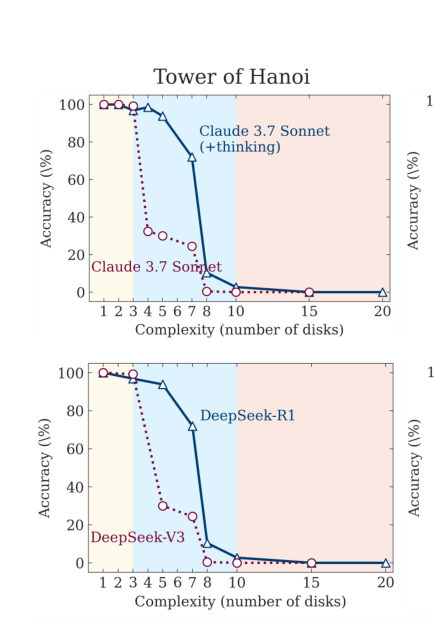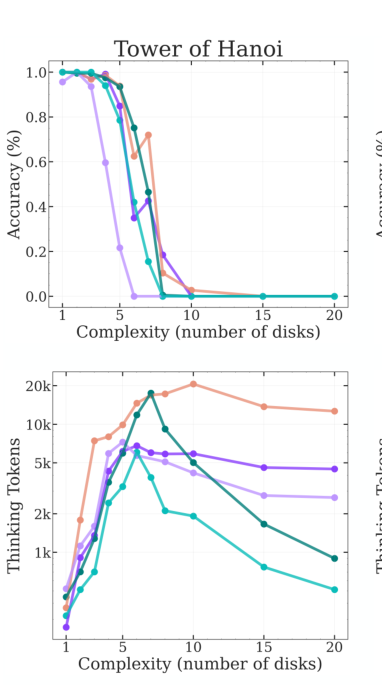paper: https://machinelearning.apple.com/research/illusion-of-thinking
The paper shows that the current Large Language Models(LLMs) and Large Reasoning Models (LRMs) experience a complete accuracy collapse on reasoning tasks after a threshold on complexity.
This was demonstrated by using simple games like Tower of Hanoi and River Crossing. Via this paper the questions
Are models capable for generalizable reasoning or are they just really good at pattern matching?
The Setup
love how simple the setup is Games like Tower of Hanoi
- both simple to understand and require not knowledge other than the rules
- Are easy to verify both the complete and partial solutions
- The complexity of the problem can easily be controlled, (by say , the number of disks in Tower of Hanoi)
Now they just give the LLMs/LRMs the rules and ask them to solve them.
LLMs -> Claude 3.7 Sonnet, Deepseek-R1,
LRMs(Thinking Models) -> Claude 3.7 Thinking Mode, Deepseek-V3. (LRMs are trained with explicit Chain of Though reasoning data, or use Reinforcement Learning with verifiable rewards)
Their Findings
By changing the number of discs(n) the complexity of tasks is modified
- For low complexity tasks, both LLMs and LRMs show similar results, (with sometimes LLMs doing better)
- For medium complexity tasks, LRMs be better because of their reasoning capabilities.
- For high complexity tasks, the accuracy of both LLM and LRMs completely collapse to 0%.
- Additionally, even with exact algorithms in the prompts, the models fail to execute the algorithm.

- For thinking models, there is an increase in reasoning tokens as the complexity of problem increases
- But after a certain threshold, it starts to decreases.
- This point correlates with the point where accuracy collapses

- Analysis of the thinking tokens of the models also reveals the following
- When the problems are simple, the model tends to find the solution in the initla part of the thinking
- When the problems rise in complexity, the models tend to find the solution in later parts of the reasoning.

Data Contamination
The paper also highlights data contamination problem in the benchmarks often used to showcase a model’s intelligence. It points out:
- The non thinking models eventually reach capability of thinking models
- Evaluated using (pass@k)
- For benchmarks like AIME24, and AIME25, there is a difference between the scores of thinking and non thinking models.
- For AIME24 thinking models perform much better than non thinking ones, and this gap is even wider for AIME25. the paper points two possible scenaious:
- The test are more complex (but human perforance indicates that AIME24 is lower than AIME25)
- Reduced data contamination in the newer benchmarks
Conclusion
- The paper demonstrates the limited ability of LLMs to reason after a certain point in complexity.
- They also show the inability of LLM/LRM in following exact algorithms. While the paper introduces a really simple and quite interesting way of evaluating mode’s capabilities, the evaluation task will probably fail to be a good metric as time goes on (I think). Because
As soon as a metric becomes a target, it fails to be a good metric